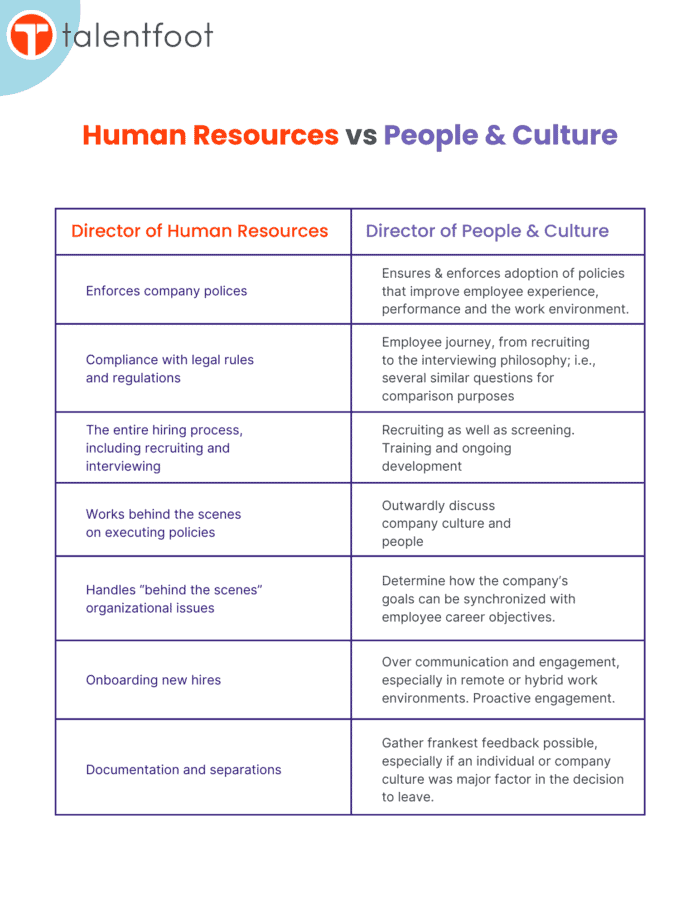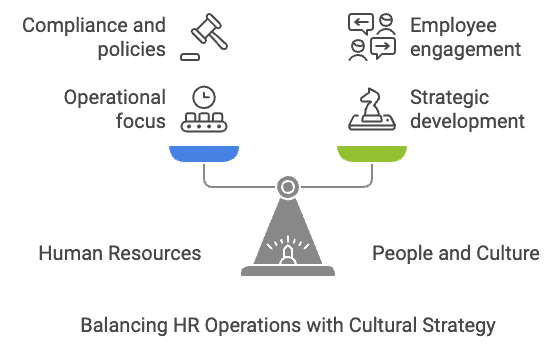Last Update: March 25, 2025
The landscape of workplace management is undergoing a seismic shift. According to Deloitte’s 2025 Global Human Capital Trends survey of nearly 10,000 business and HR leaders, organizations are facing unprecedented challenges in balancing traditional HR functions with modern culture-building initiatives. This transformation isn’t just a trend – it’s a strategic imperative.
Over the last several years, we’ve noticed a significant transformation in HR hiring. CEOs are increasingly ready to hire a Director of People and Culture, sometimes opting to forgo traditional HR roles to prioritize people and culture. PwC’s latest workforce survey reveals that 60% of employees now report being very or moderately satisfied in organizations that have made this shift, highlighting the impact of culture-focused leadership.
The Stakes Have Never Been Higher
McKinsey’s analysis shows that a preponderance of executives recognize how much external partnerships and cultural alignment help companies differentiate themselves. This is particularly crucial as the World Economic Forum expects that more than 50% of employees will need to significantly refresh their skills by 2025 due to rapid technological advancement.
Enter People & Culture.
Before we get into the fine print, this is your major takeaway: hiring a leader of people and culture instead of an HR leader reflects the business philosophy of a company’s leadership. At its core, it is the difference between management and leadership; between the administration of rules and regulations, and employee engagement and development.
The Impact of This Evolution
Mercer’s latest research indicates that 66% of organizations are prioritizing improving people managers’ skills, while 58% are focusing on enhancing the employee experience to attract and retain top talent. This dual focus demonstrates the growing recognition that both traditional HR and culture-building are essential for organizational success.

An Example:
Let’s start with a specific example, hiring.
When it comes to bringing in new employees, the human resources department spends its time on the boxes that need to be checked; I.e., recruiting, interviewing, hiring, onboarding, maintaining employee documentation, and separations.
Meanwhile, the People and Culture team focuses on the employee journey and experience; from recruiting through separation, from the interviewing philosophy (recruiting as well as screening), ongoing training and professional development, and how the company needs to intersect with the employee’s career goals.
Key Differences between a Director of HR and a Director of People & Culture at a Glance
| Aspect | Director of HR | Director of People & Culture |
|---|---|---|
| Focus | Policies, compliance, benefits | Employee experience, engagement, and culture |
| Approach | Operational | Strategic and developmental |
| Ideal for | Scaling operational HR processes | Driving culture transformation |
| Key Deliverables | Policy creation, legal compliance | Employee retention, culture initiatives |
In an organization with both a Director of HR and a Director of People and Culture, HR spends more time on operations.
When to Hire a Director of Human Resources
Hiring a Director of Human Resources is the right way to go when the company needs an executive to own one or more functions beneath the HR umbrella; talent acquisition, benefits, compliance, employee health and safety, benefits, etc.
A Director of Human Resources constructs company policies and enforces them. This leader often works behind the scenes. They are the architect of policies and then they are responsible for executing them. Conversely, the Director of People and Culture is a more outward-facing position.
In growing early to mid-stage companies, the ideal Director of HR will be a subject matter expert in both HR and people and culture. They must be fluent with policies, compliance, legal, benefits, etc., the core competencies of HR.
However, because day-to-day HR administration is time-consuming, combining HR and people and culture responsibilities to one executive will not work at scale.
When to Hire a Director of People and Culture
When a company wants to adopt a people-centric approach, it should consider hiring a people and culture leader.
Often this leader reports to the head of human resources to concentrate solely on the people and cultural aspects of the organization. Depending on the organization’s goals, the Director of People and Culture typically owns employee relations and builds a culture that promotes growth, productivity, and innovation. They play a key in role if a company needs to transform how a it attracts, develops and retains the human beings that execute the company’s strategic vision.
This executive is very visible within an organization. They are responsible for the policies that improve the employee experience. The Director of People and Culture is the employee advocate to the leadership team. Additionally, they open a two-way dialogue with employees to get honest feedback from the people.
Positioning an Organization for Success
Take a snapshot of where your organization is today and where you want to be. Are you growing rapidly? Do you have an in-house HR function in place? Remember, the key difference between these rules lies between the administration of rules and regulations, and employee engagement and development.
As companies continue to scale, the importance of culture becomes more apparent, especially as it impacts attrition and the staggering costs associated with it. In fact, toxic culture is 10 times more likely to cause turnover than compensation. The cliché’ is true – people quit their managers more than they quit their company. A Director of People and Culture and a Director of Human Resources are critical to positions when it comes to your most critical resource – your people.
Are you uncertain what the right hire is for your business needs, objectives, and budget? After reading this, you might still wonder what your organization needs. Contact us and we can help you strategize your next hire.
Frequently Asked Questions (FAQ) about HR and People & Culture
What are the key philosophical differences between HR and People & Culture approaches?
While both functions aim to support employees, their fundamental approaches differ significantly. Traditional HR departments deal mainly with administrative tasks, while People & Culture focuses on a holistic approach to managing an organization’s workforce. The shift to People & Culture represents a semantic change that reflects a fundamental shift in philosophy – recognizing organizations as intricate ecosystems of individuals with unique needs, talents, and aspirations.
How do compensation philosophies differ between HR and People & Culture approaches?
There’s a notable difference in how each role approaches compensation:
- Traditional HR typically focuses on market rates and standardization
- People & Culture takes a more holistic view, with 94% of executives and 88% of employees reporting that workplace culture matters more than compensation when joining a new organization
- 58% of employees say that company culture is more important than salary when it comes to job satisfaction
How do reporting structures typically differ?
The reporting structure often reflects the organization’s priorities:
- HR reporting to the CEO is generally preferable for strategic positioning
- People & Culture leaders often have direct access to the C-suite to influence cultural initiatives
- In organizations with both roles, People & Culture leaders sometimes report through HR, while maintaining strong dotted-line relationships with other department heads
What are the different approaches to employee development?
The approaches to employee development vary significantly:
- HR Focus: Compliance training, skill-based development, and career pathing
- People & Culture Focus: Holistic development including personal growth, cultural fit, and long-term career aspirations
- Combined Impact: 51% of workers believe their required skills will change within the next year, making both approaches valuable
How do conflict resolution approaches differ?
The handling of workplace conflicts shows distinct differences:
- HR Approach: Policy-based resolution, documentation, and legal compliance
- People & Culture Approach: Culture-first conflict resolution, focusing on relationship building and long-term harmony
- Integration: Many organizations now combine both approaches for comprehensive conflict management
What are the different metrics used to measure success?
Success metrics vary between the roles:
-
HR Metrics:
- Compliance rates
- Time-to-hire
- Cost-per-hire
- Employee turnover rates
- Benefits utilization
-
People & Culture Metrics:
- Employee engagement scores
- Cultural alignment
- Team collaboration metrics
- Innovation indicators
- Employee satisfaction with development opportunities
How do recruitment strategies differ?
The approach to talent acquisition shows clear distinctions:
- HR Directors: Focus on maintaining company standards during the recruitment process
- People & Culture Directors: Take a broader view, emphasizing cultural fit, long-term potential, and team dynamics
What are the different approaches to policy-making?
Policy development and implementation vary significantly:
- HR Approach: Process-focused, emphasizing compliance and standardization
- People & Culture Approach: People-based, not policy-based, with flexibility for individual circumstances
How do change management approaches differ?
Change implementation strategies show distinct characteristics:
- HR Focus: Structural changes, policy updates, and procedural compliance
- People & Culture Focus: Cultural transformation, employee experience, and long-term adoption
What are the different approaches to performance management?
Performance evaluation and management show clear distinctions:
- HR Approach: Standardized reviews, KPI tracking, and formal documentation
- People & Culture Approach: Continuous feedback, development-focused conversations, and holistic performance views
How do budget priorities differ?
Resource allocation often reflects different priorities:
-
HR Budget Focus:
- Compliance training
- Benefits administration
- Legal consultation
- HRIS systems
-
People & Culture Budget Focus:
- Employee experience initiatives
- Culture-building activities
- Leadership development
- Innovation and collaboration tools





